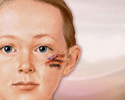Hearing loss
Decreased hearing; Deafness; Loss of hearing; Conductive hearing loss; Sensorineural hearing loss; PresbycusisHearing loss is being partly or totally unable to hear sound in one or both ears.
-
Considerations
Symptoms of hearing loss may include:
- Certain sounds seem overly loud in one ear
- Difficulty following conversations when two or more people are talking
- Difficulty hearing in noisy areas
- Trouble telling high-pitched sounds (such as "s" or "th") from one another
- Less trouble hearing men's voices than women's voices
- Hearing voices as mumbled or slurred
Associated symptoms may include:
- Feeling of being off-balance or dizzy (more common with Ménière disease and acoustic neuroma)
- Feeling of pressure in the ear (usually due to fluid behind the eardrum)
- Ringing or buzzing sound in the ears (tinnitus)
-
Causes
Conductive hearing loss (CHL) occurs because of a mechanical problem in the outer or middle ear. This may be because:
- Sound is not reaching the eardrum.
- The eardrum is not vibrating in response to sound.
- The 3 tiny bones of the ear (ossicles) are not conducting sound properly.
Causes of conductive hearing loss can often be treated. They include:
- Buildup of wax in the ear canal
- Damage to the very small bones (ossicles) that are right behind the eardrum
- Fluid remaining in the ear after an ear infection
- Foreign object that is stuck in the ear canal
- Hole in the eardrum
- Scar on the eardrum from repeated infections
Sensorineural hearing loss (SNHL) occurs when the tiny hair cells (nerve endings) that detect sound in the inner ear are injured, diseased, do not work correctly, or have died. This type of hearing loss often cannot be reversed.
Sensorineural hearing loss is commonly caused by:
- Acoustic neuroma
- Age-related hearing loss
- Childhood infections, such as meningitis, mumps, scarlet fever, and measles
- Ménière disease
- Regular exposure to loud noises (such as from work or recreation)
- Use of certain medicines
Hearing loss may be present at birth (congenital) and can be due to:
- Birth defects that cause changes in the ear structures
- Genetic conditions (more than 400 are known)
- Infections the mother passes to her baby in the womb, such as toxoplasmosis, rubella, or herpes
The ear can also be injured by:
- Pressure differences between the inside and outside of the eardrum, often from scuba diving
- Skull fractures (can damage the structures or nerves of the ear)
- Trauma from explosions, fireworks, gunfire, rock concerts, and earphones
-
Home Care
You can often flush wax buildup out of the ear (gently) with ear syringes (available in drug stores) and warm water. Wax softeners (like Cerumenex) may be needed if the wax is hard and stuck in the ear.
Take care when removing foreign objects from the ear. Unless it is easy to get to, have your health care provider remove the object. Don't use sharp instruments to remove foreign objects.
See your provider for any other hearing loss.
-
When to Contact a Medical Professional
Contact your provider if:
- Hearing problems interfere with your lifestyle.
- Hearing problems do not go away or become worse.
- The hearing is worse in one ear than the other.
- You have sudden, severe hearing loss or ringing in the ears (tinnitus).
- You have other symptoms, such as ear pain, along with hearing problems.
- You have new headaches, weakness, or numbness anywhere on your body.
-
What to Expect at Your Office Visit
The provider will take your medical history and do a physical exam.
Tests that may be done include:
- Audiometric testing (hearing tests used to check the type and amount of hearing loss)
- CT or MRI scan of the head (if a tumor or fracture is suspected)
- Tympanometry
The following surgeries may help some types of hearing loss:
- Eardrum repair
- Placing tubes in the eardrums to remove fluid
- Repair of the small bones in the middle ear (ossiculoplasty)
The following may help with long-term hearing loss:
- Assistive listening devices
- Safety and alert systems for your home
- Hearing aids
- Cochlear implant
- Learning techniques to help you communicate
- Sign language (for those with severe hearing loss)
Cochlear implants are only used in people who have lost too much hearing to benefit from a hearing aid.
- Audiometric testing (hearing tests used to check the type and amount of hearing loss)
References
Arts HA, Adams ME. Sensorineural hearing loss in adults. In: Flint PW, Francis HW, Haughey BH, et al, eds. Cummings Otolaryngology: Head and Neck Surgery. 7th ed. Philadelphia, PA: Elsevier; 2021:chap 152.
Eggermont JJ. Types of hearing loss. In: Eggermont JJ, ed. Hearing Loss. Cambridge, MA: Elsevier Academic Press; 2017:chap 5.
Kerber KA, Baloh RW. Neuro-otology: diagnosis and management of neuro-otological disorders. In: Jankovic J, Mazziotta JC, Pomeroy SL, Newman NJ, eds. Bradley and Daroff's Neurology in Clinical Practice. 8th ed. Philadelphia, PA: Elsevier; 2022:chap 22.
Le Prell CG. Noise-induced hearing loss. In: Flint PW, Francis HW, Haughey BH, et al, eds. Cummings Otolaryngology: Head and Neck Surgery. 7th ed. Philadelphia, PA: Elsevier; 2021:chap 154.
Shearer AE, Shibata SB, Smith RJH. Genetic sensorineural hearing loss. In: Flint PW, Francis HW, Haughey BH, et al, eds. Cummings Otolaryngology: Head and Neck Surgery. 7th ed. Philadelphia, PA: Elsevier; 2021:chap 150.
Weinstein B. Disorders of hearing. In: Fillit HM, Rockwood K, Young J, eds. Brocklehurst's Textbook of Geriatric Medicine and Gerontology. 8th ed. Philadelphia, PA: Elsevier, 2017:chap 96.















